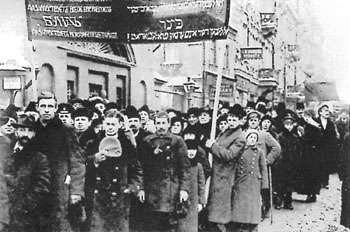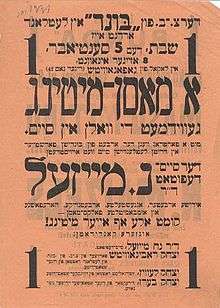General Jewish Labour Bund in Latvia
| Part of a series on the |
| Jewish Labour Bund |
|---|
 |
| 1890s to World War I |
| Interwar years and World War II |
| After 1945 |
|
| People |
| Press |
| Associated organisations |
| Splinter groups |
|
| Categories |
|
The General Jewish Labour Bund in Latvia was a Jewish socialist party in Latvia, adhering to the political line of the General Jewish Labour Bund and existed from 1900 until 1940, when it was banned shortly after the Soviet occupation of Latvia in 1940.
The beginnings of the Latvian Bund
The first local Bund organizations were established on 1900 in Daugavpils and on 1902 in Riga. In the autumn of 1904, the Riga Committee of the Latvian Social Democratic Workers Party and the Riga Committee of the Bund signed a co-operation agreement and founded the Riga Federative Committee. The main liaisons were the engineer Jānis Ozols ("Zars") and the railwayman Samuel Klevansky ("Maksim"). Bund was active during the 1905 Russian revolution, organizing demonstrations and fighting units.[1]
The first Bundist activities in independent Latvia began with a congress of members of Unzer Tsayt in Riga in December 1918, soon after Riga was conquered by Soviet Russia.[2] After the conclusion of Latvian War of Independence, in the fall of 1920 a Central Bureau of the Latvian Bund was constituted. The Latvian Bund became an autonomous organization affiliated with the Latvian Social Democratic Workers' Party. The Bund had one seat in the Central Committee of the Latvian Social Democratic Workers Party.[3] The Bund, as well as other left-wing groups in Latvia after the Latvian War of Independence, was under suspicion as Communist supporters. On June 20, 1921 the president of the party Abraham Braun "Sergei" (1881-1940) was sentenced to death by a military tribunal for spreading Communist propaganda but released after international socialist outcry over the sentence.[3]
The relations among Jewish socialists and with the rest of the socialist movement were far better than in Poland; during elections of 1918 two Bundists were elected, then four at the Riga municipal council election in 1919, on a common list of the Social Democratic bloc, which gained 36 of the 96 seats.
The party published the biweekly Di naye tsayt for seven years.[3] According to Daniel Blatman, there were 500 active members of the Latvian Bund in 1934.[2]
The Bundist members of the Latvian Parliament

As pointed out by Frank Gordon, "Between the two world wars Latvia was the only country where the Bund had a parliamentary representative of its own.".,[4] and Bind was only one of a few Jewish parties represented in the 1st Saeima, 2nd Saeima, 3rd Saeima and 4th Saeima.
Itzhak Berss (Īzaks Berss), father of Lipman Bers, represented the interests of the Bund in the Constitutional Assembly of Latvia, elected in April 1920. He was later the director of Riga Jewish gymnasium where Yiddish was the language of education. From 1922 until 1934 he was Riga City councilman. He was removed from office after the 1934 Latvian coup d'état on the grounds of "political unreliability".[5] On June 14, 1941 he was arrested and deported by Soviets to Siberia from where he was released only in 1956.
Dr. Noah Meisel, Daugavpils city council member, was subsequently elected for the Bund in the 1st Saeima in 1922, and again in 1925 and 1928, but was not reelected in 1931.[6] He was arrested and deported by the Soviet authorities after the Soviet invasion and annexation of Latvia in 1940 and died in exile in far Northern Russia in 1956.[5]
According to Valdis Lumans, "the leftist Bund more often than not sided with Latvian Social Democratic Workers' Party more than with the Jewish bloc" (comprising Agudath Israel, the Zionists and the Jewish National Democratic Party).[7]
International affiliation
After World War I, the Latvian Bund sent a representative, Raphael Abramovitch, to the Russian Social Democratic Labour Party (Menshevik) delegation at the founding Vienna conference of the International Working Union of Socialist Parties in 1921, where he was particularly active in association with the Menshevik leader Julius Martov. He "emerged as one of the recognized leaders of the Vienna Union".[8]
Communist splinter group
In 1920 Jewish communists also formed the illegal underground battle organisation Kamp Bund (The Bund of Struggle), which functioned as the Jewish section of the banned Communist Party of Latvia. Its leading members included Mark Donskoy, Iosif Lensky and Abraham Gurevich.[9]
Sources
- ↑ Jews During the Revolution of 1905
- 1 2 Daniel Blatman, Bund, The YIVO Encyclopedia of Jews in Eastern Europe
- 1 2 3 Minczeles, Henri. Histoire générale du Bund: un mouvement révolutionnaire juif. Paris: Editions Austral, 1995. p. 390
- ↑ Gordon, Frank (Efrayim) (1990). Latvians and Jews Between Germany and Russia. Stockholm: Memento. ISBN 91-87114-08-9.
- 1 2 Press, Bernhard (2000). The murder of the Jews in Latvia: 1941-1945. Northwestern University Press. ISBN 978-0-8101-1729-7.
- ↑ Latvia, Encyclopaedia Judaica
- ↑ Lumans, Valdis (2006). Latvia in World War II. Fordham University Press. p. 547. ISBN 978-0-8232-2627-6. Retrieved 2009-10-31.
- ↑ Liebich, André (1997). From the other shore: Russian social democracy after 1921. Cambridge, MA: Harvard University Press. ISBN 978-0-674-32517-3. Retrieved 2009-10-31.
- ↑ Dribins, Leo. "The history of the Jewish Community in Latvia". Riga: Ministry of Foreign Affairs of the Republic of Latvia. Retrieved 2009-10-31.
Additional bibliography
- Latvian: Vitâlijs Ðalda, Bunda organizâcijas Latvijâ: 1900–1917